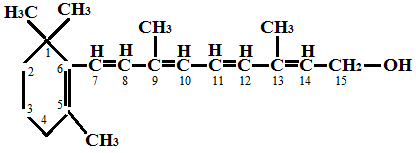Vitamin A - Occurrence and Absorption
Vitamin A is a complex alcohol and is nowadays called retinol. Its aldehyde derivative is called retinal. It has following structure; ring shown is called β-ionone ring

There are several isomers of vitamin A; the most important of these are 13-cis retinol found in many fish liver oils and 11-cis retinol which occurs in the retina. Vitamin A is quite heat stable but it is destroyed at high temperature in the presence of O2 or air. Vitamin A has been synthesized.
 Occurrence of Vitamin A
Occurrence of Vitamin A
Vitamin A occurs as such in nature only in the animal kingdom. It occurs in highest concentration in the liver oils of certain species of fish, e.g. halibut (richest source), shark and cod; it also occurs in the livers of other animals, egg yolk and milk. In plants it occurs as its precursors, pro-vitamins A or carotenes which are yellow-red pigments found especially in carrots, yellow corn, sweet potato, peaches and spinach. The carotenes do not have any vitamin A activity but these are converted to vitamin A in the liver. The conversion of carotenes to vitamin A is decreased in diabetes mellitus and hypothyroidism. Of the many carotenes, β-carotene is the most efficient precursor of vitamin A. This is due to its symmetrical molecule each of which can give rise to two molecules of vitamin A. Carotenes, however, poor sources of vitamin A because they are not absorbed completely and their conversion to the active vitamin A is not 100% complete.
 Absorption of Vitamin A
Absorption of Vitamin A
Vitamin A occurs in nature as its esters which are hydrolyzed by esterase present in the pancreatic juice to fatty acids and free vitamin A alcohol. Vitamin A is absorbed here mainly by the lymphatic system. It is then re-esterified within the walls of the small intestine and appears in the blood Plasma as its esters. Carotenes are absorbed in the small intestine. Bile salts help in carotene and vitamin A absorption.




